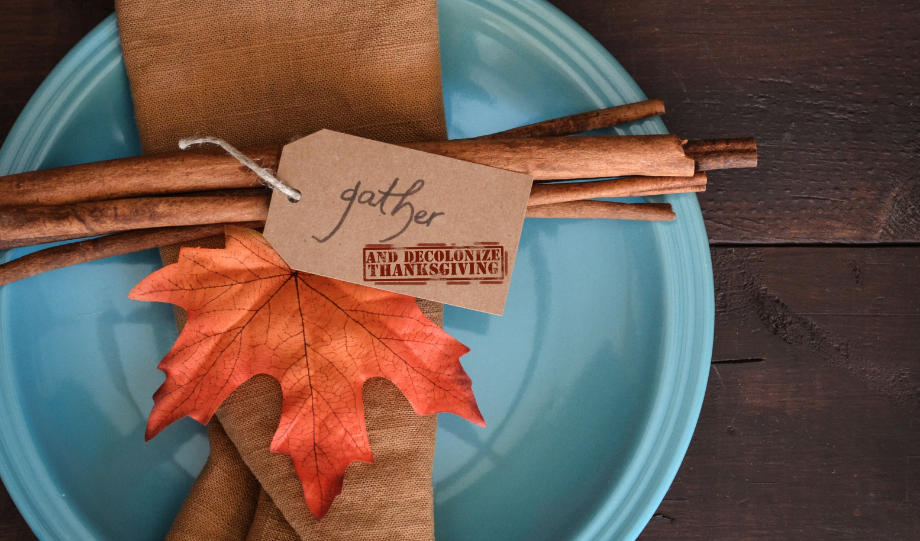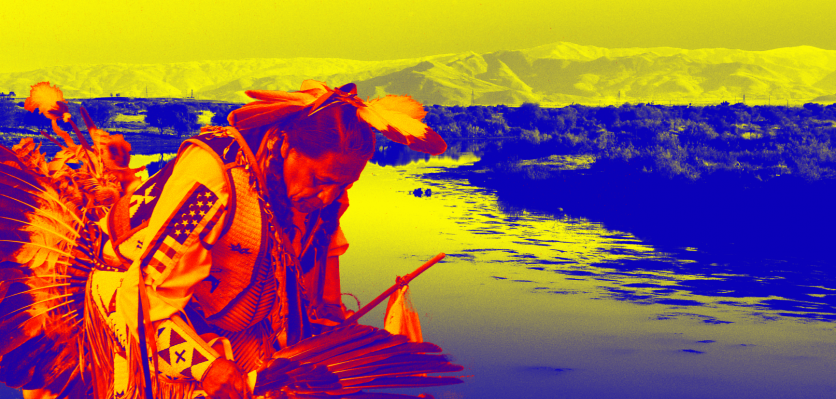From Western Armenia to New England: De-mythifying Indigenous stories of ‘Thanksgiving’
November 26, 2019
When you think of Thanksgiving, what comes to mind? The holy trinity of this holiday (food, football, and family) is as American as Mickey Mouse and the Apple logo. But underneath the sweet casserole scents and drowsy poultry meat belies a dark history. Read on to see why we, Armenian-Americans, should reconsider the way we approach this “holiday."
Forgotten
In the summer of 2017, I impulsively booked a flight to Turkey to traverse the lands of my ancestors in the east of the country (Western Armenia). With just two weeks to prepare, I seized every opportunity to tell anyone within a 10-foot radius about my upcoming trip. As expected, every American I spoke to was excited, and just about every Armenian was agitated, warning me to keep my identity a secret, to not ask too many questions, to go in and out like a mouse, quiet and invisible. All of this advice emanated from an unspoken truth that every Armenian knows by birthright: the genocide ended but it didn’t really end. Over a century later, we are still not welcome on our lands.
I was aware of this reality and did my best to keep expectations at bay. We spent nine days exploring the towns, villages, and neighborhoods that were razed to the ground and rebuilt to hide their Armenian pasts; we met with descendants of genocide survivors who continue to guard their Armenian secret with the kind of fear that our great-grandparents would have had in 1916; we visited church ruin after church ruin, all of them either looted to oblivion, repurposed as mosques, or used as hay storage for barn animals.
Something breaks inside you when you see a lamb defecate on the rubble where your ancestors, not too long ago, prayed and baptized their babies and buried their dead. This was a kind of cruelty that was foreign to me, or was it?
Feasting on a myth
This Thursday, millions of Americans will gather around their dinner tables in loosened belt buckles (though, let’s face it, sweats were invented for this occasion—à la Joey from Friends) to consume as much food as humanly possible. Somewhere between the cranberry sauce and the double-stuffed sweet potatoes, everyone will share one thing they’re thankful for.
Though the consumerist excesses of the holiday season creep up earlier and earlier every year, the central focus around this day is to recreate the First Thanksgiving: a supposedly peaceful feast between the Wampanoag Nation (Native Americans) and the Pilgrims (English colonists) during an especially difficult harvest in 1621.
But lest you think that gluttony is the only deadly sin we commit on this day, many immigrant communities, including Armenians, have put their own spin on this classic American holiday, imbuing a multicultural flavor to the otherwise bland palate that is turkey stuffing and genocide.
Yes, you read right. The holiday we all love so dearly is an insidiously deceptive cover-up, a literal "whitewashing" of history. After centuries of violent tactics that killed, assimilated, and deprived natives of their lands, languages, religions, foods, and traditions, Native American presence and culture has become all but an afterthought for most Americans. Even on this day of reflection, we hardly ever stop to consider what happened to the people who were here long before our nation became a "melting pot."
Though I was always aware of the cultural erasure, I am ashamed to say that I never truly felt the gash of its wounds until I visited our ancestral lands.
From Mush to Mohegan, bound by genocide
As I walked the dusty paths along the Aratsani River (renamed Murat River) in Mush, I pictured the ancient Armenian folklore that may have inspired the name of this land. When the pagan goddess of love, Astghik, would come down from her celestial dwelling on Mount Ararat to bathe in these waters, she would create a “mush” (or “mist”) to occult herself from voyeuring men. I wondered how many Turks knew this story? Alas, how many Armenians even know?
Throughout our trip, we utilized the internet to research the long-forgotten towns, villages, schools, churches, and landmarks of our pre-genocide past. There were no signs, tourist centers, or monuments to educate passersby on the authentic history of these lands. My loud rage turned to quiet indignity when I realized that the lands I live on now were also once violently appropriated from their previous tenants, whose records of life, pre-colonization, have been wiped clean from most Americans’ consciousness—including mine.
Mohegan, Iroquois, Mohawk, Seneca, Miamis, Sequin are all streets (named after various tribes) within a quarter-mile radius of my home. We roll off these names in our daily lives without realizing what they mean. Who were the Mohegans, Iroquois, Mohawks, Senecas, Miamis, and Sequins? What happened to them? And why were we never taught about them in our schools—like my middle school, King Philip, named after the Wampanoag chief who led one of the most decisive series of battles between natives and colonists in American history?
My state name, Connecticut, has a reputation for being too long, too weird-sounding, and too difficult to write or pronounce. But how many know that it is a European corruption of the poetic Mohegan word, “quinetucket,” meaning “beside the long, tidal river?” The Mohegan language is now extinct, its relics remaining in a few scant words in Americans’ repertoire today, such as my oft-teased state name. I did not need to travel halfway across the world to see destruction and appropriation. It exists, quite literally, in my backyard.
Imagine
On Thanksgiving, most American families burn off their calories by raising their blood pressures watching football games. This year, for the first time since 2015, the Washington Redskins will not be playing on the holiday; the term “redskin” refers to a time when bounty hunters collected scalps and skins of natives for rewards. There has been an ongoing campaign to change the name, but the team (and many of their fans) will not budge.
Imagine, for a moment, if Turkey had a holiday where they commemorated the “peaceful exchange” between indigenous Armenians and colonizing Turks, while dressing up as “gavurs” (meaning “infidels,” a derogatory term for Armenians) to cheer on their favorite sports team, named after the literal skinning of Armenians. How would you feel? What we subject Native Americans to every single day in this country is no better than how we were—and continue to be—treated in Ottoman/Turkish society.
A century ago, oppression, colonization, and genocide led to the violent expulsion from our native lands—lands on which we were indigenous. Our community dispersed across the world, seeking refuge from turmoil and persecution. North America may have been a safe haven for our ancestors, but their new home was all but liquidated of its indigenous communities, in much the same fashion that our people were in Western Armenia. While our families were repairing here, native families were being destroyed. Celebrating the “peaceful dinner” between natives and their colonizers not only perpetuates a false version of history, but it also makes us accomplices to this revisionism. As Armenians, we are all too familiar with the perils of revisionist (and denialist) history.
We can do better
It is no exaggeration that one may view Thanksgiving as a kind of April 24th (Armenian Genocide Remembrance Day) for Native Americans. Indeed, many natives actually call it a National Day of Mourning instead. But if I never stopped to consider these questions before, then how could I ever expect the same from Turks living on indigenous Armenian land?
 "Gather...and decolonize Thanksgiving" (Photo: Debby Hudson; remixed by h-pem)
"Gather...and decolonize Thanksgiving" (Photo: Debby Hudson; remixed by h-pem)
Genocide is, needless to say, a traumatic thing for any community to experience. But what if we used our common history of suffering, exile, and trauma as a means to connect deeper with those who are native to the lands that we now also call home? Respecting Native American culture and history will not only make us better Americans, but also better Armenians.
In recent years, a growing number of Armenian Americans have organized and participated in various intercultural events with Native American groups and individuals. It’s high time we all joined in to bust the myth of this “holiday,” and, in doing so, become better allies for our fellow indigenous communities.
Wondering how to engage in Thanksgiving in a more conscientious way? Stay tuned for our Armenian Thanksgiving Guide!



Lilly Torosyan
29 Nov, 2019 18:50:12 Edited
I appreciate the kind words, Carolyn! That video was excellent. Thank you for sharing!
0

Join our community and receive regular updates!
Join now!


Ani_Artsakh
30 Nov, 2019 18:13:54 Edited
Well done, Lily jan!
2
Reply